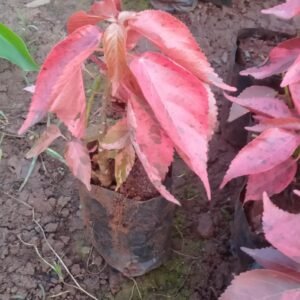The Anjeer 5×6 plant stands as a testament to nature’s ability to offer both sustenance and pleasure in one neat package. Figs have a storied history, woven into the fabric of ancient civilizations, mythology, and even religion. They are often described as fruits of wisdom and nourishment. The specific 5×6 variety refers to the size of the fruit, which typically measures around 5 centimeters in diameter and 6 centimeters in height, making it a plump and generously proportioned fig.
Anjeer is not just any fruit; it is a marvel of nature. From its intriguing, almost exotic texture to its natural sweetness, biting into a ripe fig feels like an indulgence. The outer skin, a thin layer that can range from deep purple to greenish-brown, gives way to the inner flesh, which is soft, pinkish, and dotted with tiny seeds that provide a pleasant crunch. This contrast between the smoothness of the flesh and the gentle crisp of the seeds makes each bite memorable.
Imagine planting an Anjeer 5×6 tree in your backyard. At first, it seems unassuming, its broad, lobed leaves giving it a tropical air. But over time, this tree transforms. Its roots dig deep into the soil, and its branches spread out, creating a canopy of green. Underneath its shade, the world feels a little cooler, a little more serene. Then, one day, small fig fruits begin to emerge, at first hard and green, but over time, they ripen and swell. Their skin softens, signaling that they are ready to be picked.
Harvesting an Anjeer 5×6 fruit is a small joy in itself. You approach the tree, your hands reaching for the plump fruit hanging from the branches. With a gentle twist, it comes free, and for a moment, you pause to admire it. The fig, warm from the sun, feels almost sacred in your hand, as if holding centuries of history and tradition. It’s not just fruit—it’s a connection to the past, to ancient farmers who cultivated these trees millennia ago in the fertile soils of the Mediterranean, Persia, and India.
The Anjeer 5×6 variety is particularly prized because of its large fruit size and high yield. Each fig is packed with nutrients, making it an incredibly healthy addition to any diet. Figs are known for being rich in fiber, antioxidants, and vitamins such as A, B, and K. They are also loaded with essential minerals like potassium, magnesium, and calcium. Eating them regularly can aid digestion, improve heart health, and provide a natural boost of energy. The tree itself is hardy and resilient, thriving in warm climates and requiring minimal maintenance once established.
In many homes, an Anjeer tree holds a special place. Its fruit is often seen as a luxury, something to be enjoyed fresh off the tree or dried and saved for the colder months when fresh fruit is scarcer. Some even use figs in homemade jams, preserves, or desserts, allowing the sweetness of the fruit to enhance a variety of dishes. The versatility of figs is part of what makes the Anjeer 5×6 plant so beloved.
Beyond the kitchen, the Anjeer tree is also a symbol of abundance and life. In many cultures, the fig tree represents fertility, knowledge, and prosperity. Its deep roots, wide branches, and generous fruits make it a metaphor for stability and growth. In ancient times, the fig tree was often planted near homes as a symbol of good fortune, and in some places, it still holds that same significance today.
Growing an Anjeer 5×6 plant can also be a deeply rewarding experience, especially for those who love to nurture life. While it doesn’t require much attention, it does need warmth, sunshine, and patience. With the right care, it rewards its caretaker with a bounty of fruit, year after year. The first harvest feels like a culmination of your efforts, but it’s only the beginning. The tree continues to produce, giving back more than it ever takes. It’s a reminder that sometimes, the simplest things in life—like tending to a plant—can yield the greatest rewards.
As you tend to your Anjeer 5×6 plant, you become part of a long tradition of fig growers, from the ancient Greeks and Romans to farmers in the fertile valleys of India. The tree, in return, roots itself not just in your garden but in your life. It’s there through seasons of growth and rest, offering its fruit as a small, delicious reminder of the richness and beauty of nature.
In this way, the Anjeer 5×6 plant is more than just a source of food—it’s a living piece of history, a provider of sustenance, and a symbol of life’s enduring cycle. Whether you plant it for its sweet fruit, its symbolism, or simply for the pleasure of watching it grow, the Anjeer plant will surely leave a lasting mark, much like the legacy of figs themselves.






Reviews
There are no reviews yet.